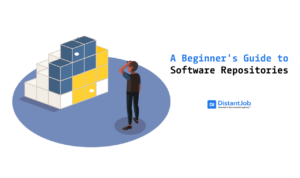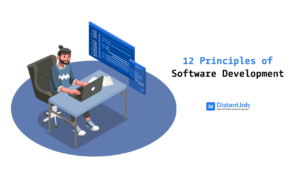You’re ready to build a kickass app for your business. But, which technology should you go for if you’re looking for cross-platform development at lower costs? Flutter? Or React Native?
According to Statista, Flutter and React Native have been amongst the most popular cross-platform technologies for mobile app development over the last two years. The adoption rate continues to rise, and they have begun to surpass their competitors.
However, they both have their differences and pros and cons. Before beginning your project, you must have a clear understanding of these aspects to make a smart choice.
Let’s see who’s the winner in 2022 in terms of performance and more: React Native Vs Flutter.
React Native vs Flutter: At A Glance
| Comparison | React Native | Flutter |
| Release Date | March 2015 | May 2017 |
| Founder | ||
| Programming Language | Javascript | Dart |
| Type | Software Framework | Software Dev. Kit |
| License | Open-source | Open-source |
What Is React Native?
In the simplest definition, React Native developers use JavaScript, and React Native is an open-source mobile app framework. React Native, as the name suggests, combines native development with React which is a JavaScript library that is used to build user interfaces.
React Native was created by Facebook in 2013; it had started as an internal Facebook project and its preview was released in January 2015 during the React.js conference. Facebook launched React Native in March 2015 and it became available on GitHub.
That said, it is important to understand that applications created with React Native are not web apps. React Native is used to developing regular Android and iOS apps by using JavaScript and React instead of Java or Kotlin.
React Native is used for:
- Building Android and iOS apps by using JavaScript.
- Easy cross-platform development.
- Utilizing the same mobile UI Library as React.
There are many successful apps that are built using React Native. Here are some of those that most of us use as often as every few hours!
- Facebook Ads Manager
- Bloomberg
- Tesla
- Skype
- Wix
What is Flutter?
Flutter, Google’s mobile app SDK, is used for smooth and quick cross-platform mobile application development. This means there’s no need to create separate apps for separate platforms like Android and iOS. Flutter, and other frameworks, apply one codebase for both platforms.
This is very similar to React Native in the sense that React Native is also a cross-platform mobile application development framework that uses one codebase and negates the need for creating separate apps for separate platforms.
Some popular apps that use Flutter are:
- Alibaba
- Tencent
- Google Ads
- Hamilton
- Reflectly
Pros and Cons of Flutter and React Native
Pros of Flutter
- Flutter has a “hot reload” feature that allows developers to make changes to the app in a jiffy. Moreover, it literally takes milliseconds for these changes to be reflected on the app without losing the current state.
- Flutter has its own widgets which makes it platform agnostic. These are widgets that adhere to the Cupertino (iOS) and Material Design principles (Android). Because of this you need to hire just one certified Flutter developer! No need for different teams for Android and iOS.
- With Java for Android and Swift or Objective C for iOS, there is no need to re-write code since it seamlessly integrates. This allows for rapid iteration cycles and reduces build time since testing is only necessary for one codebase.
- The UI structure of the app stays the same no matter what device your consumers are using. This means even on old devices, the UI is as crisp and smooth as it is on the latest phones.
- Codesharing: It is ideal for MVP development because code can be developed and shared between platforms more easily and quickly.
Cons of Flutter
- The libraries and plugins are impressive, but they fall short of React Native in terms of functionality. Moreover, Dart (programming language used to code Flutter apps) is not as popular or used as JavaScript.
- Your developers can’t always find the functionality they’re looking for in existing libraries because Flutter is still very new. This means they might have to spend time creating custom functionality.
- The vector graphics and animation rendering plugins occasionally cause problems.
- It does not support operating systems like tvOS, Android Auto, CarPlay, and watchOS.
- The standard release processes must be followed before patches and updates can be pushed into applications.
Pros of React Native
- One of the biggest advantages of using React Native is that it uses a language that is wildly popular among developers – JavaScript. This makes the React Native community bigger than the Flutter community, giving it a slight edge for hiring developers over Flutter.
- APIs can be rendered natively on the host platform without the use of HTML or CSS markup.
- It translates the markup of an application to mimic authentic user interface elements while maintaining high performance.
- To keep up with changing user states, the app uses the ecosystem’s robust set of UI libraries and other components.
- It has error reporting and intelligent debugging tools.
- Hot reloading makes it possible to load fresh code into a running program. It allows your developers to make changes, fix bugs and introduce new features to the app at lightning speed. This is a commonality between React Native and Flutter.
Cons of React Native
- Like any other web application frameworks, you can’t expect a React Native app experience to be a 100% replica of that which is achieved with native apps. It’s very similar to a native app but it is not the same.
- It’s possible that certain native UI elements won’t be supported by APIs rendered natively, which would cause an odd appearance in the UI.
- When looking for a better implementation, it’s important to check for third-party libraries that can be used. Because React Native has a big number of libraries, many are either low quality or abandoned. This means that your developers will need to check the number of issues thoroughly to avoid using an abandoned package.
- Parallel threading and multi-processing are not supported, resulting in poor performance.
- React Native apps are bigger than Native apps because React Native apps need to include a library that supports JavaScript code. This is because Android doesn’t have such a functionality. Bigger apps mean more space taken up on your consumer’s devices.
- Debugging: Using Chrome’s debugger to modify and investigate scripts and UI components can be difficult.
Now, let’s compare Flutter and React Native in terms of real-life performance, app support, project size, and more.
Flutter Performance vs React Native
Flutter
When compared to React Native, Flutter applications perform better. It does not need a bridge to interact between the native modules since native components are already available.
For instance, a simple “hello world” program would give 60 frames per second and render each frame in less than 16 milliseconds in Flutter.
Frames were dropped in smaller numbers. Flutter utilizes the Skia graphics package that enables the user interface (UI) to be repainted with each change in the application’s view. It’s no surprise that Flutter is able to run effectively at 60 frames per second.
React Native
When compared to Flutter, the performance of React Native is noticeably worse. As previously mentioned in the cons list, this is due to the JavaScript bridge being utilized to connect native components. Flutter’s “hello world” program dropped far fewer frames per interval than React Native’s “hello world” app.
The application stutters when it takes more than 16 milliseconds to render a program. Third-party libraries like Proguard, which further optimize bytecodes, may increase the speed of your program.
React Native vs Flutter: Animation
Flutter
It’s easy to get started with animation in Flutter because of its simple tools, elements, and even custom widgets.
As part of Dart, there is a feature called generational garbage collection that helps to create UI frames for transient object codes. Thanks to this feature of Dart, it is possible to eliminate UI clutter, garbage, and animation slowness throughout the development process.
React Native
React Native has different UI packages like React Virgin, Shoutem, and Ant Design that make it harder to build uniform designs across platforms. This is also because Android’s Material Design and iOS’s Style Design are constantly evolving, making it difficult for React Native to stay up.
Flutter Vs React Native: Architecture
Flutter
Flutter has a multilayered structure. Root functions, or platform-specific widgets, provide the foundation of a basic application built on it. Basic widgets that integrate with the platform and renderer layers are then added on top of that layer.
The animation gestures that transport API requests to the program’s foundation are located just above the rendering layer of the application. Platform-specific embedder like A C/C++ engine is used to execute Scaffold.
Flutter BLoC is an option if you want to keep the presentation layer distinct from the business logic. This design enables professional and novice Flutter developers alike to construct sophisticated apps with simple components.
React Native
React Native has a thread bridge between the JavaScript and Native threads. By implementing these features, the native API can connect with the JavaScript code. To execute all programs, React Native for iOS utilizes a separate JavaScriptCore.
But on Android, JavaScriptCore is included as part of the application. The native functionality may be improved, but the app’s size will inevitably go up, perhaps causing performance difficulties or device latency.
Flutter Vs React Native: Usability
Flutter
Flutter is not yet capable of handling complicated tasks. But it can be used to make prototypes and test your concept quickly. That’s why many startups consider flutter as a viable option for developing Minimum Viable Products (MVPs) (MVP).
React Native
React Native can be used to build complicated native applications. However, it’s vital to keep in mind that this is only likely to be viable if you combine React Native with native app development.
At that point, it is more likely that your app will be hybrid than cross-platform at that point. Complex React Native apps require not only Javascript but also native development skills to be built.
Flutter Vs React Native: Learning Curve
Flutter
Getting started with Flutter Flutter isn’t that difficult. Writing code in Dart is a unique experience, but it makes working with Flutter a lot more straightforward. Beginners require just a minimal familiarity with native Android or iOS programming to get started with this framework. Developers praise the documentation of Flutter because it is more user-friendly than that of React Native.
React Native Learning Curve
If you have Javascript developers, learning React Native will be a breeze. However, web development is distinct from mobile app development, which makes it difficult for mobile developers to learn and implement the framework. There are a number of libraries and tutorials for React Native that can make the learning process easier.
Flutter Vs Native React: Project Size
Flutter
Flutter’s smallest hello world app weighed in at around 7.5 megabytes. The virtual machine of Dart and the C/C++ engine determine the size of this project using Flutter. But Flutter is able to self-contain all of its code and assets so that it does not have to worry about the size. The code is also made smaller by using tags like “split-debug-info.”
React Native
When native dependencies were included, the Hello World app’s size in React Native grew to 13.4 MB, from its original 7 MB size. You can reduce the size of the app using a tool like Proguard or by auto-generating all native and external libraries into separate builds.
When to Choose React Native and When to Choose Flutter?
When we think of React Native Vs Flutter, the choice is tough. The thing is that both of the platforms are truly exceptional and can give your business a quick and smooth app.
Here’s how you can decide which of the two is best for your business.
- Which one of the two is your developers proficient in? Dart or JavaScript? If the answer is Dart, then Flutter is your choice and if it’s JavaScript then go for React Native.
- If you don’t have a development team yet then decide based on whether you’d like your app to be built using native UI components. If yes, then you need to hire React Native developers!
- If you’d like your app to be brand centric in terms of the look and feel of the UI, then add Flutter developers in your “to hire” list!
Between, React Native Vs Flutter, whatever you may choose in the end, we recommend a discussion with an experienced developer or developers to get the best idea. However, know that both of these frameworks are excellent for cross-platform app development and none is going to disappoint you in the end.
React Native vs Flutter: Project Cost
The overall cost of your app development will depend on the scope and complexity of the app; team composition, type of engagement (contract vs full-time), as well as location of the developers.
When it comes to the platform, you can also consider the average salaries of Flutter and React Native developers to estimate the cost. For instance, according to Glassdoor, the average salary of a Flutter developer in the US is $76000 whereas a React Native developer earns an average of $88000.
Since Flutter is often more suited at an early stage to build a prototype with a comparatively lesser average developer salary, you might want to opt for it if you have budget constraints.
Final Thoughts
It is safe to conclude that the choice between Flutter and React Native will depend on your project scope. Flutter is a fantastic tool for rapidly prototyping and working collectively on projects. On the other hand, building simple native and cross-platform apps with React Native is a breeze.
You can go for Flutter if you have a limited budget and your concept does not need full native capabilities. But if your goal is to create small and fast native apps with asynchronous build and responsive user interface, React Native might be a better choice.
Whatever be your choice, DistantJob can help you hire skilled Flutter developers, as well as React Native qualified developers. Get in touch with our team and we can help you find the perfect match!




